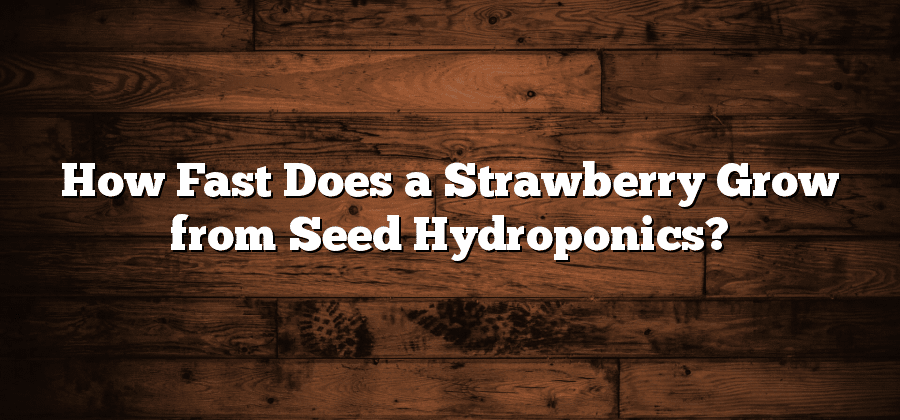Understanding the Growth Cycle of Strawberries in Hydroponics
Strawberries have a unique growth cycle that varies slightly depending on the specific variety and growing conditions. In hydroponics, this cycle can be divided into four main stages: vegetative growth, flowering, fruiting, and senescence. During the vegetative growth stage, strawberry plants focus on establishing a strong root system and developing leafy green foliage. This stage is crucial for providing the necessary energy and nutrients for the plant’s overall growth and development.
Once the plants have reached a certain maturity, they enter the flowering stage. This is when small, white flowers begin to appear on the strawberry plants. These flowers are responsible for the pollination process, which can be facilitated manually by gently shaking the flower clusters or by introducing bees or other pollinators into the hydroponic system. After successful pollination, the flowers gradually transform into small, green fruits that will eventually ripen into juicy, red strawberries. It is important to provide optimal growing conditions, such as adequate light, temperature, and nutrient levels, to ensure healthy fruit development.
Understanding the growth cycle of strawberries in hydroponics is essential for successful cultivation. By carefully managing each stage and providing the necessary care, hydroponic growers can expect to harvest delicious strawberries throughout the growing season. Proper knowledge of the growth cycle allows growers to anticipate and address any challenges that may arise, ensuring a bountiful harvest and thriving strawberry plants.
Selecting the Right Strawberry Varieties for Hydroponic Cultivation
When it comes to selecting the right strawberry varieties for hydroponic cultivation, there are several factors that need to be considered. One of the key considerations is the growth habit of the strawberry plant. Some varieties are better suited for hydroponics due to their compact growth habit, which makes them easier to manage in a controlled environment. These varieties tend to have shorter internodes and smaller leaves, making them ideal for vertical or stacked systems.
Another important factor to consider is the yield potential of the variety. Different strawberry varieties have varying levels of productivity, with some producing larger fruits or higher quantities of berries. It is crucial to select varieties that are known for their high yield potential in hydroponic systems. This ensures that you are maximizing the productivity of your hydroponic setup and getting the most out of your investment.
In addition to growth habit and yield potential, it is also important to consider the flavor and appearance of the strawberries. Different varieties have distinct flavors and characteristics, ranging from sweet and juicy to tart and tangy. Ultimately, selecting a variety that offers a desirable flavor profile will enhance the overall experience for consumers.
As you navigate through the vast array of strawberry varieties available for hydroponic cultivation, remember to consider the growth habit, yield potential, and flavor profile of each variety. By carefully selecting the right strawberry varieties, you can ensure the success of your hydroponic cultivation and enjoy a bountiful harvest of delicious, high-quality strawberries.
Preparing the Hydroponic Setup for Strawberry Seed Germination
To successfully germinate strawberry seeds in a hydroponic setup, proper preparation of the system is essential. Begin by thoroughly cleaning all the equipment that will be used, including the seed trays, grow media, and any containers or reservoirs. This helps ensure a sterile environment that reduces the risk of disease and promotes healthy growth. Additionally, sterilizing the equipment prevents any existing weeds or unwanted seeds from contaminating the hydroponic system.
Next, carefully select the appropriate grow media for strawberry seed germination in a hydroponic setup. There are various options available, such as perlite, coco coir, or vermiculite. It is crucial to choose a medium that retains moisture well and provides excellent drainage. The media should be free of any chemicals or additives that could harm the delicate strawberry seeds. A sterile and well-draining grow media creates an optimal environment for the seeds to sprout and develop roots.
Once the equipment is cleaned and the grow media is chosen, it’s time to set up the hydroponics system for strawberry seed germination. Start by filling the seed trays with the selected grow media and level it out, ensuring it is evenly distributed. Make sure that the trays have proper drainage holes to prevent waterlogged conditions that can lead to rotting seeds. Afterward, lightly pack the grow media to secure it in place while leaving enough space for the strawberry seeds to be placed on top.
Proper preparation of the hydroponic setup not only creates a favorable environment for the germination of strawberry seeds but also lays the foundation for successful cultivation. The cleaning and sterilization process minimize the risk of disease, while the careful selection of grow media ensures the right balance of moisture and drainage. With the hydroponic setup fully prepared, it is now time to move on to planting the strawberry seeds and providing them with optimal growing conditions.
Providing Optimal Growing Conditions for Hydroponic Strawberry Seedlings
After successfully germinating strawberry seeds in your hydroponic setup, it is crucial to provide optimal growing conditions for the seedlings. One important factor to consider is the temperature. Strawberry seedlings thrive in temperatures between 60-75°F (15-24°C). It is essential to maintain a consistent temperature range to ensure healthy growth and development. Sudden fluctuations in temperature can stunt the growth of the seedlings and hinder their ability to produce a strong root system.
In addition to temperature, proper lighting plays a vital role in the growth of hydroponic strawberry seedlings. Providing sufficient light is crucial for photosynthesis, which is essential for healthy plant growth. High-intensity discharge (HID) lights such as metal halide or high-pressure sodium lamps are commonly used in hydroponic setups. These lights emit a spectrum of light that closely resembles natural sunlight and promotes vigorous growth. It is important to position the lights at an optimal distance from the seedlings to avoid burning or damaging them. Additionally, a timer can be used to simulate day and night cycles, ensuring the seedlings receive the appropriate amount of light for their growth stage.






